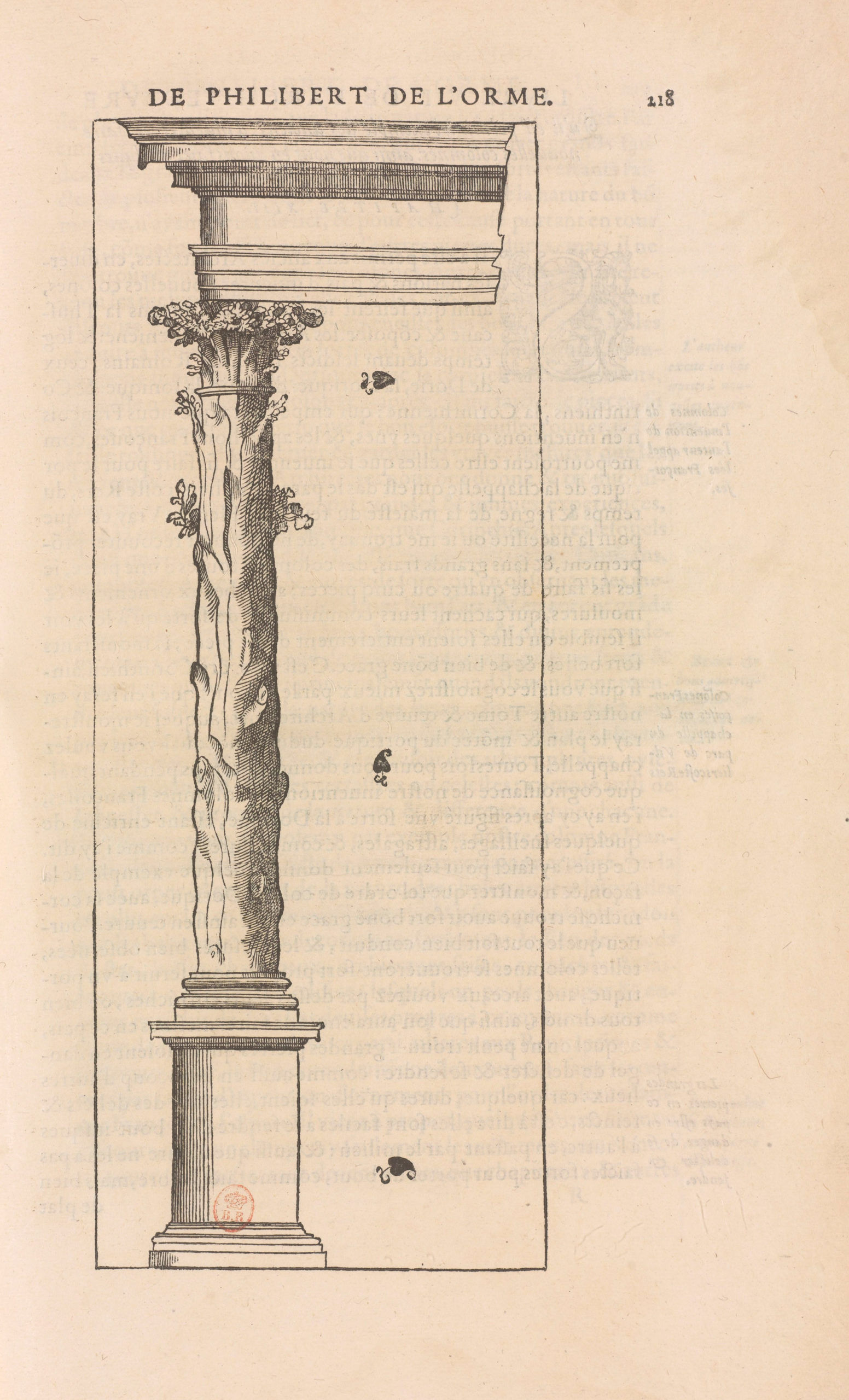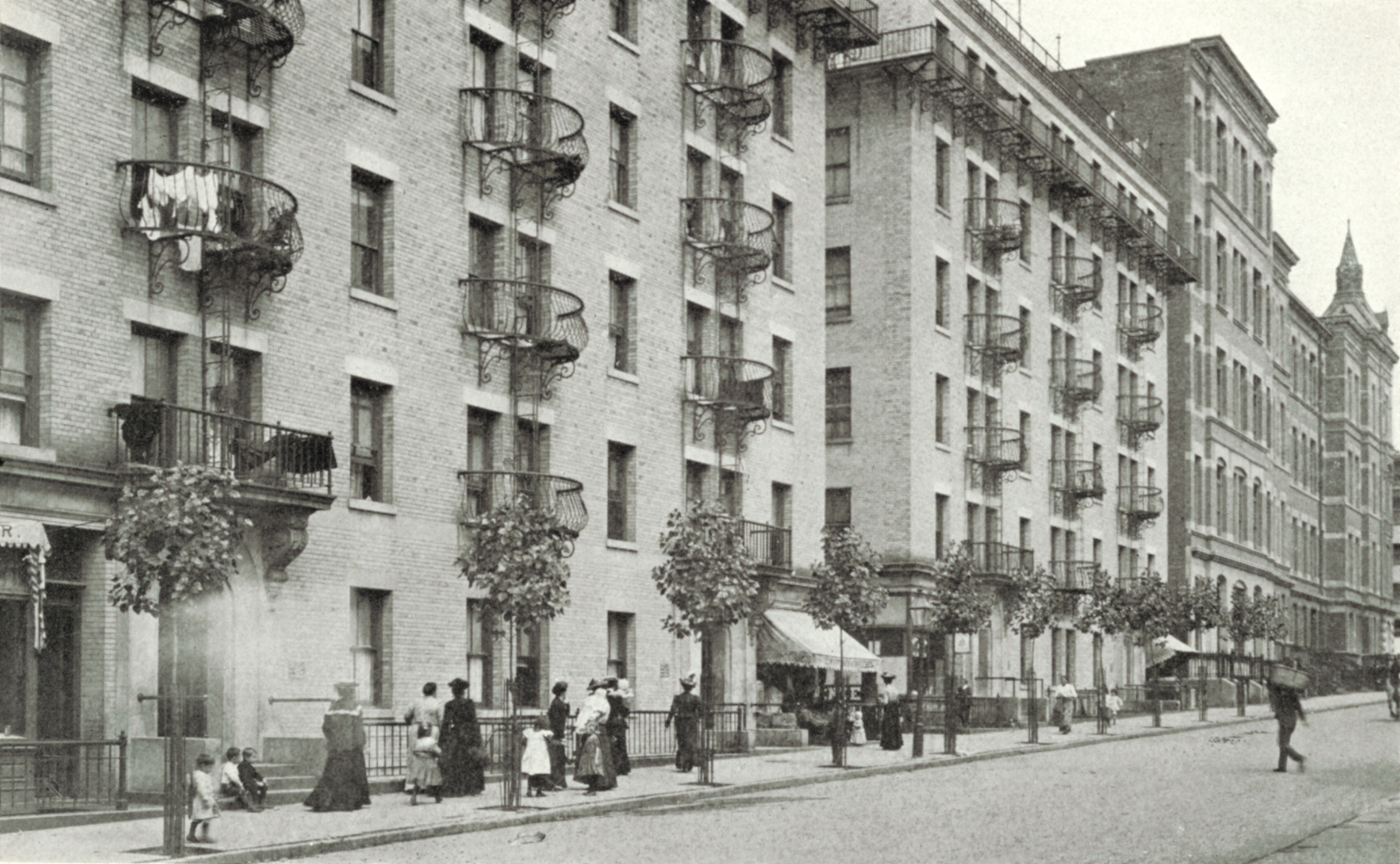Sonja Dümpelmann. Seeing Trees: A History of Street Trees in New York City and Berlin. New Haven: Yale University Press, 2019.

The Roman engineer Vitruvius, writing in the first century BCE, suggests that trees were the original model for columns. The classical colonnade became the precursor to the tree-lined street. The repetition of identical elements evokes a kind of control, an organizing principle for settings otherwise subject to continual change. The tree metaphor persisted into the Renaissance with the architect Leon Battista Alberti, in the fifteenth century, pointing out the similarity between the increased diameter of the bottom of columns and the root flare of the planted tree. An association of trees and streets evolved. By the late nineteenth century, tree-lined streets were part of every urban planner’s tool kit. Sonja Dümpelmann examines two approaches to street tree planting in her recent book, Seeing Trees: A History of Street Trees in New York City and Berlin. In the narrowest sense, her book is a case study of two cities and their approach to trees, but in the broader context, she weaves together the overlapping perspectives of urban design, tree management, and engineering and seamlessly integrates them with shifting political and social values. Her book is not only a contribution to the history of street tree planting but an original contribution to urban history.
The nature-versus-culture divide applies here as it does to much of urban landscape history. “Cities were naturalized,” Dümpelmann writes, “and trees were urbanized.” In American cities, street planting was part of the Romantic “urban pastoral” movement of the late nineteenth century. Advocates proselytized about bringing elements of the countryside into the city, arguing that this would offer respite from the tension inherent in city life. In New York City, trees were part of the urban sanitizing movement that created Central Park. Tree care itself still depends on the health metaphor originating in that period. Trees are evaluated in terms of health and disease. Terms like immune systems, resilience, and injury are part of tree care. Until recently arborists were called tree surgeons. Conversely, contemporary urban tree-planting practices embrace sophisticated technology to create manipulated growing conditions—an honest, transparent recognition of the unique conditions of the urban landscape. Tree species are hybridized to create selections that can withstand urban conditions. Soil mixes are created with the specificity of prescription drugs. Planting pits are engineered. It is now clear that what happens underground is as essential (if not more) to tree survival as what happens above.
In American cities, grand street-tree-planting projects are still part of political campaigns—a bread-and-circus approach to garner votes in upcoming elections with no provision for aftercare. Despite lessons learned about urban planting as an ongoing process that involves nurturing young plants, providing water, and protecting trees from damage and from insects and disease, municipal governments often leave trees on their own to survive with little intervention. Advocates promote trees in terms of ecosystem services, pointing out that trees moderate local weather conditions, filter pollution, and reduce global warming. Trees symbolize civic pride and the regeneration of neighborhoods. Altogether this is a heavy burden to place on young plants. Every city has tree haters as well as tree lovers. If, on one hand, trees clean the air, on the other, they are dirty: They drop leaves and fruit on sidewalks and cars. They attract bugs. Trees block signs and storefronts. Although a seemingly benign activity, tree planting still attracts controversy.
Tree species selected for urban streets have been transformed by research and hybridization. But the selection of tree species is still vulnerable to fads. Dümpelmann quotes landscape gardener Andrew Jackson Downing in 1847: “There is a fashion in trees that sometimes has a sway no less rigorous than that of a Parisian modiste.” The tree of heaven (Ailanthus altissima), once recommended as a street tree, was quickly rejected because of its overwhelming odor. Norway maples (Acer platanoides), widely planted because of their ability to thrive in stressful conditions, are now banned in some communities because of their propensity to self-seed. American elms (Ulmus americana) are lost to disease. Dümpelmann reveals how the selection of tree species is vulnerable to xenophobic reactions both in Germany and the United States. Trees are caught in the debate between native-plants-only advocates and those who champion botanical cosmopolitanism.
The strength of Dümpelmann’s treatment of street tree planting in New York is her ability to point out the differences between the work of municipal government, high-minded philanthropic groups, and community-based initiatives that recognize the needs of specific neighborhoods. Top-down versus bottom-up. New York’s tree-planting schemes are still controlled by the New York City Commissioner’s 1811 plan that overlaid a grid from Houston Street to 155th Street, ignoring the island’s rolling topography. The architectural historian Hilary Ballon calls New York City’s grid plan “a living framework.” It is the tension between the rigidity of the grid and the looseness of the crowns of trees that defines the classic New York City street. While the practical benefits of street tree planting drove municipal efforts, philanthropic groups were also aware that tree-lined streets gave the rapidly growing city a veneer of a refined environment. One of the first to join the movement was Gifford Pinchot, head of the United States Forest Service. As residents of the city, Pinchot and his wife, Cornelia, were active members of the Tree Planting Association, founded in 1897. In addition to his interest in scientific forestry, Pinchot believed that trees were “the only form through which the residents of the city can come in daily contact with nature as we know it in the woods and fields.”
By the early twentieth century, the New York landscape had become a gendered space dominated by male professionals. Dümpelmann describes how women gained entrée to tree-planting projects by virtue of their social position and influence. Women were valued for their roles as caregivers, child protectors, and municipal housekeepers. Tree-planting efforts were a natural fit. Cartoonists had a field day. Later in the twentieth century, women were important leaders in groups like the Neighborhood Trees Corps and the Magnolia Tree Earth Center, which began to work in neighborhoods left behind in earlier planting efforts. African American groups, especially those in Bedford-Stuyvesant, organized local tree-planting projects to regenerate their neighborhood where the street was park space. Community groups came to resist top-down government initiatives and well-meaning but naïve philanthropic efforts.

Both New York and Berlin began street planting to build a healthy environment for residents. In contrast to New York City’s efforts, street tree planting in Berlin is inextricably associated with destruction and loss. Berlin’s important achievements in urban planning in the nineteenth and early twentieth century—broad tree-lined avenues and gracious parks—were destroyed by war. Trees were lost in massive numbers during World War II. Many were lost to bombing; those that remained were cut down for firewood and building materials. Dümpelmann’s treatment of Berlin’s rebuilding includes many small, poignant stories, from the struggle to plant trees on rubble to the protection of the city’s mountain ash (Sorbus aucuparia) street trees because of the nutritional value of their fruits. The partition of the city into East and West sectors after World War II removed any possibility of comprehensive urban reforestation. It was only after reunification that renewed planting efforts could build on Germany’s earlier research in scientific forestry, expanding on their admired analytic methods and fieldwork. The goal of nineteenth-century German forestry research was to increase yield, yet the basic methods of scientific analysis used for research were intriguing to tree specialists well beyond the field of forestry. German plant scientists experimented with vegetative propagation and hybridization techniques to create “the perfect tree.” They warned of the dangers of monoculture. Charles Sprague Sargent, the Arnold Arboretum’s first director, assembled a valuable collection of German forestry manuals.
Information exchange in the twentieth century between American street tree specialists and their German counterparts resulted in more sophisticated and experimental planting techniques. Ideas on tree management spanned from the individual plant to the greater tree population of a city. The American landscape architect Elbert Peets, a long-time advocate of street tree planting as an essential component of city design, collaborated with the German urban planner Werner Hegemann on American Vitruvius: An Architect’s Handbook of Civic Art, published in 1922. This book provided a compendium of examples of urban forms, including the integration of trees into streets and boulevards. William Solotaroff, the New Jersey-based city forester and author of the widely distributed Shade-Trees in Towns and Cities (from 1911), often referred to German models for street planting.
Dümpelmann uses the complicated story of loss and rebirth of Unter den Linden, Berlin’s famous tree-lined boulevard, to mirror Berlin’s fractured history. It was created in the late seventeenth century and connects the pleasure ground of the Berlin Palace to the Brandenburg Gate. Long admired as one of the great promenades of Europe, the design was referenced in Frederick Law Olmsted’s 1868 proposal for the parkways of Brooklyn. Unter den Linden is now freed from the isolation of East Berlin and is being restored with its long allée of lindens as part of the greater unification of the city.
For some, there is a certain cynicism about planting street trees in cities. As Dümpelmann reflects, street trees have an “inbuilt a priori obsolescence.” They die. In both New York and Berlin, we see that the ability of trees to thrive is contingent on human intervention. But even given that responsibility, we no longer question that they are an essential part of urban infrastructure. We have enough confidence in urban life to no longer reference rus in urbe, the country in the city. Trees on city streets are health-enhancing; they have a strong sensory presence. But in the end, it is the power of the eye, the visual value of trees on streets that sustains their place in the city.
Phyllis Andersen is a landscape historian and former director of the Institute for Cultural Landscape Studies of the Arnold Arboretum
Citation: Andersen, P. 2020. How Trees Were Urbanized. Arnoldia, 78(2): 44–47.